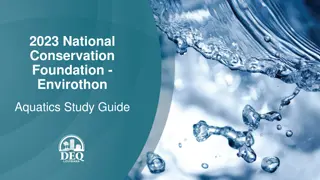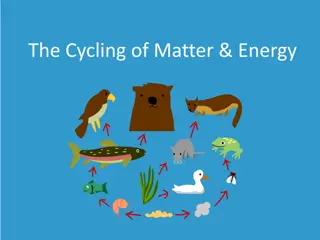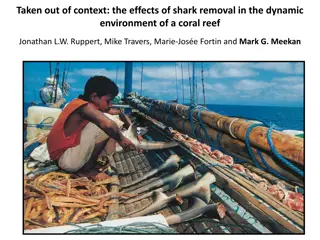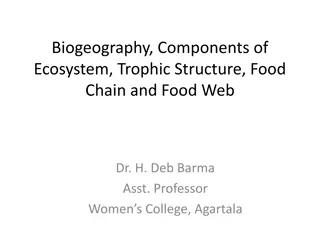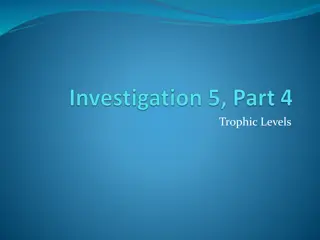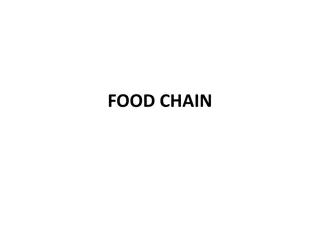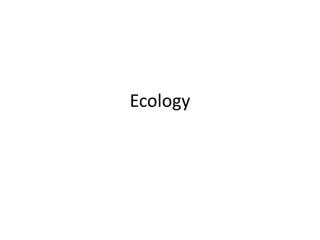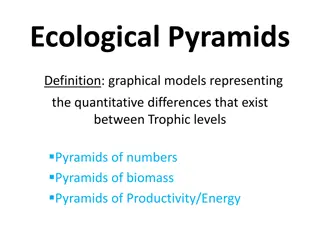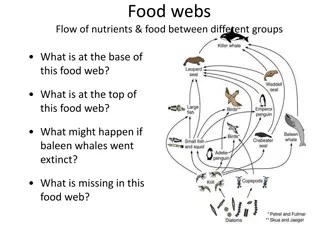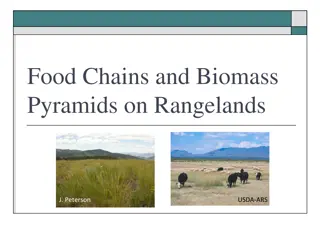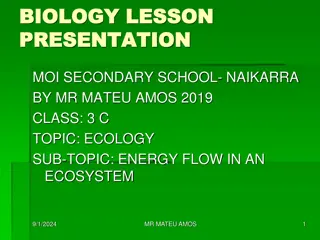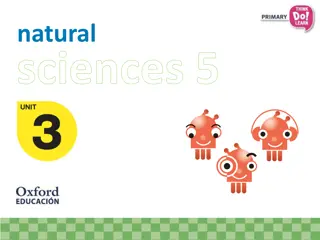2023 National Conservation Foundation - Envirothon
Explore the intricate dynamics of aquatic ecosystems and wetlands conservation through this comprehensive study guide. Discover the importance of watersheds, the hydrologic cycle, aquatic food webs, energy flow at trophic levels, and common macroinvertebrates in Louisiana. Learn about different wetl
3 views • 27 slides
Environmental Math and Efficiency Analysis
Explore environmental math problems related to forest loss, uranium energy conversion, and energy transfer through trophic levels. Dive into calculations involving forested hectares, converting uranium into fluorescent light, and energy efficiency at different trophic levels.
1 views • 33 slides
Understanding the Cycling of Matter and Energy in Ecosystems
Explore the interconnected web of life within biomes and ecosystems, where organisms play vital roles in maintaining balance. Learn about producers, consumers, and decomposers, and how energy flows through different trophic levels. Dive into the world of primary, secondary, and tertiary consumers, a
0 views • 24 slides
Impacts of Shark Removal on Coral Reef Dynamics
This study delves into the repercussions of shark removal on the intricate ecosystem of coral reefs. It explores the correlation between shark abundance, reef fish community structure, benthic disturbances like cyclones and bleaching, and the synergistic effects of top-down and bottom-up processes.
1 views • 18 slides
Understanding Biogeography, Ecosystem Components, Trophic Structure, Food Chain, and Food Web
Biogeography delves into the origin, distribution, and adaptations of plants and animals, aiding in earth surface differentiation. Ecosystems involve interactions between biotic and abiotic elements, forming trophic structures, biodiversity, and material cycles. Learn about the concepts, definitions
0 views • 29 slides
Understanding Ecosystems: Structure, Components, and Functions
Ecosystems are intricate units where living organisms interact with each other and the environment. They consist of biotic (living) and abiotic (non-living) components, interrelated in a chain of interactions. Biotic components include autotrophs, heterotrophs, and decomposers, while abiotic compone
0 views • 15 slides
Exploring Trophic Levels and Energy Flow in Ecosystems
Understanding trophic levels and energy flow in ecosystems is vital for comprehending the intricate relationships between producers, consumers, and decomposers. Energy enters the food web through producers, transferring from one trophic level to another. Explore the dynamics of Mono Lake ecosystem a
0 views • 19 slides
Understanding Ecosystem Dynamics: The Food Web Explained
An ecosystem comprises various organisms living together in a community. Energy flow through food chains depicts how organisms obtain energy and nutrients from one another. Food chains show the sequence of feeding relationships, while a food web illustrates interconnected chains within a community.
1 views • 13 slides
Understanding Energy Flow in Ecosystems
Energy flow in ecosystems is vital for sustaining life as it moves through different trophic levels. Primary producers harness solar energy to create organic material, which is then consumed by herbivores, carnivores, and decomposers, forming intricate food chains. Terms like biomass, productivity,
0 views • 8 slides
Understanding Food Chains and Ecosystems in Nature
Explore the interdependence of living organisms in their environment through food chains, trophic levels, and the roles of producers, consumers, and decomposers. Learn how energy flows through ecosystems, the classification of animals based on feeding styles, and the vital role of decomposers in rec
0 views • 34 slides
Understanding the Intricacies of Food Chains in Ecosystems
Food chains play a crucial role in the transfer of energy within ecosystems. They consist of various trophic levels where organisms either consume or are consumed by others. Different types of food chains like grazing, detritus, predator, and parasitic chains interact to maintain the balance of ener
0 views • 15 slides
Understanding Ecology and Basic Concepts in Environmental Science
Explore the fundamental concepts of ecology and environmental science, including species, habitat, population, community, autotrophs, heterotrophs, environment components, food chains, and trophic levels. Learn about the intricate relationships between living organisms and their surroundings in this
0 views • 35 slides
Understanding Ecological Pyramids: Models of Trophic Relationships
Ecological pyramids are graphical models that depict quantitative differences between trophic levels in an ecosystem. They come in three types: Pyramids of Numbers, Pyramids of Biomass, and Pyramids of Productivity/Energy. Pyramids of Numbers show the number of organisms at each trophic level, Pyram
0 views • 4 slides
Understanding Food Webs and Trophic Levels in Ecosystems
Food webs illustrate the flow of nutrients and energy between different organisms in an ecosystem. At the base of a food web are the primary producers, while predators occupy the top. If baleen whales were to go extinct, it could disrupt the balance of their ecosystem. Biomass decreases as energy is
0 views • 11 slides
Understanding Food Chains, Trophic Levels, and Biomass Pyramids on Rangelands
Explore the intricate dynamics of food chains, trophic levels, and biomass pyramids on rangelands through informative visuals and explanations. Learn how energy flows through different levels, the concept of biomass pyramids, and the impact of vegetarianism on food chains and energy efficiency.
0 views • 11 slides
Exploring Energy Flow in Food Webs
Dive into the intricate relationships of organisms in various food chains and webs, understanding the flow of energy from producers to consumers and the impact of changes in population sizes. Discover the significance of trophic levels and the role of energy pyramids in ecosystems.
0 views • 9 slides
Understanding Animal Communities in Geography
Animal communities are formed by various species occupying the same habitat or microhabitat, interacting within a biological community. Each species has a unique ecological niche, influencing interactions like competition and predation. Communities consist of producers, herbivores, carnivores, and m
1 views • 9 slides
Understanding Energy Flow in Ecosystems: A Comprehensive Overview
Energy flow in an ecosystem involves the transfer of energy from producers to consumers through different trophic levels, with only a small fraction of energy being passed on at each level. This process is essential for sustaining life within an ecosystem, highlighting the interconnectedness of all
0 views • 11 slides
Understanding Energy Flow in Ecosystems: A Visual Guide
Explore the intricate dynamics of energy flow in ecosystems through a collection of visually engaging images depicting autotrophs, heterotrophs, food chains, ecological pyramids, and more. Dive into the concept of trophic levels, food webs, and feeding relationships, unraveling the journey of energy
0 views • 13 slides
Understanding Energy Flows and Matter Cycles in Living Systems
Interactions among living systems and their environment involve the movement of matter and energy. Energy flows through trophic levels, starting with primary producers like plants and autotrophs converting solar energy. It then progresses to primary consumers, secondary consumers, and tertiary consu
1 views • 15 slides
Exploring Ecosystem Dynamics: Food Chains, Energy Pyramids, and Trophic Levels
An exploration of key concepts in ecosystem dynamics, including food chains, energy pyramids, secondary consumers, and trophic levels. Discover the interconnected relationships between organisms in an ecosystem and the vital role of key species. Dive into the differences between food chains and food
0 views • 16 slides
Enhancing Ecological Sustainability through Gamified Machine Learning
Improving human-computer interactions with gamification can help understand ecological sustainability better by parameterizing complex models. Allometric Trophic Network models analyze energy flow and biomass dynamics, but face challenges in parameterization. The Convergence Game in World of Balance
0 views • 12 slides
Understanding Ecosystems: An In-depth Exploration
Delve into the fascinating world of ecosystems through this comprehensive guide, covering the definition, components, relationships, classifications, and key learnings. Explore the intricate balance between living and non-living elements, trophic relationships, food chains, and diverse ecosystem typ
0 views • 11 slides
